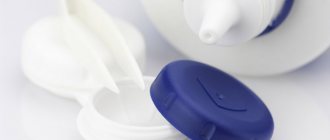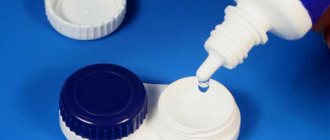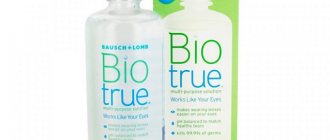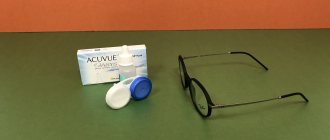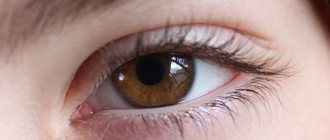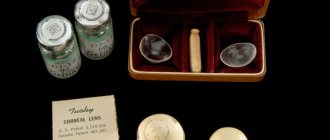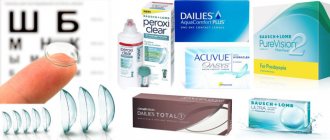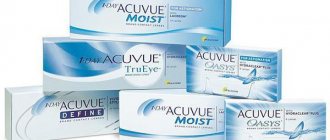What types of good solutions are there?
Modern lens care products are divided into the following types.
Universal
They disinfect the surface of the product and destroy pathogenic microorganisms. The main advantage of the composition is its pH level, which completely matches the pH of tears in a healthy human eye. Moisturizing occurs due to a specially added substance - hyaluron.
Multifunctional
Such solutions combine all the functions necessary for caring for contact lenses:
- Hydration. After washing, the lens becomes softer, the feeling of a foreign body in the eye, dryness and burning disappears.
- Cleansing. The liquid removes urban dust and various particles accumulated on products during the day. In the morning you can see a small sediment in the container.
- Disinfection. Daily disinfection prevents the proliferation of harmful microorganisms, thereby protecting the eye from infections.
- Removing deposits. Protein deposits accumulate on contact products while worn. Removing them will make vision clearer and increase oxygen permeability.
Peroxide
Peroxide cleaning can be one-stage or two-stage. Both consist of a 3% solution of hydrogen peroxide, fixed with stabilizers (sodium chlorine and phosphate compounds) and a neutralizing component that makes the peroxide harmless to the eyes. It is this concentration that helps the liquid get inside the cell membrane and achieve complete cleansing from dirt, fungi and various types of viruses.
In a one-stage system, the neutralizer function is performed by a platinum disk, which is placed in a container for CL. And in the two-stage method - an enzyme cleaner in tablets. Hydrogen peroxide in such systems is neutralized within 6 hours.
Attention! The peroxide system is intended specifically for cleaning and disinfecting lenses, and not for rinsing and rinsing them. It is necessary to strictly follow the instructions, only then is the use of this method safe for eye health
Enzymatic
The principle of operation is to destroy the chemical bond of protein molecules and split it into simpler particles: amino acids and peptides, which easily leave the surface of the CL and remain at the bottom of the container.
The enzyme solution can remove even complex protein deposits.
Solutions come in the following types: ready-to-use liquid, powder for diluting the solution, effervescent enzyme tablets.
When purchasing the latter, you need to keep in mind that you can only use freshly prepared enzyme solution. It cannot be stored or used more than once.
Important! The average duration of action of the enzyme solution is about 30 minutes. After cleaning, it is necessary to immerse the lenses in a multifunctional solution for at least 4-5 hours
What types of contact lens solutions are there?
During daily wear, contact products lose moisture and protein deposits form on them, as a result of the vital activity of the eye and tear ducts. Also, lenses lose oxygen saturation and elasticity if you wear them for a very long time without taking them off at night.
The solution for contact lenses is designed to restore the properties of the product, cleanse protein deposits and disinfect. To maximize the life of the optics and ensure safe use, it is necessary to use a product that will reliably perform its functions.
Depending on the main indications for use, liquids are divided into several groups:
- universal;
- enzymatic;
- peroxide.
Ophthalmologists recommend solutions for use on a purely individual basis. It is recommended to consult with your doctor before purchasing.
Universal
Universal liquids are used for storing, disinfecting and cleaning contact lenses. Reusable products must be cleaned of natural waste and dust, moistened and disinfected before each reuse. Classic solutions perform all three functions.
Lenses must be placed in liquid overnight and during any breaks in wear. They should be stored exclusively in a special liquid if they are not on the eye. The universal solution provides all the necessary care for optical products, so you can wear them without the slightest discomfort or dryness in the eye.
Enzyme/enzyme
Enzyme or enzyme liquids are used for the most effective cleaning of heavy protein deposits. Enzyme tablets are combined with hydrogen peroxide, so they thoroughly remove any type of contamination, especially those of natural origin. Enzyme cleaning is used for traditional lenses with a long service life.
How to clean and store contact lenses
Since lens solutions have been used for quite a long time, some rules have emerged that promote better lens storage. By following these rules, you can significantly extend the life of your lenses and also ensure their sterility.
These rules include:
- prevent infection from getting into the solution;
- if discomfort occurs, replace the solution;
- check the expiration date of the solution upon purchase;
- follow the instructions that come with the solution;
- clean the lenses with the solution immediately after removing them;
- Change the solution in the container regularly.
Sterility in a solution can only be guaranteed if various bacteria or small particles of dirt are not introduced into it. The ingress of foreign particles can contribute to the appearance and development of bacteria, as well as infections in the eyes.
If, while wearing lenses, it was noticed that they began to cause discomfort, then the recently purchased solution may be contributing to this. If this is indeed the case, then it needs to be replaced with a more suitable one. To do this, you can consult an ophthalmologist.
Since lens solution has a limited shelf life, it must be replaced after this period.
It is important that the solution is not used after the expiration date. This can cause not only deterioration in the quality of the lenses, but also problems with the mucous membranes of the eyes. Instructions for its use are attached to each solution
By following these instructions, you can safely wear lenses. Thus, after purchasing the solution, you need to carefully study the instructions. The solution should be used immediately after removing the lenses. Since bacteria and dirt accumulate on the lenses during the day, they need to be cleaned at the end of the day. To do this, a solution is used to rinse the lenses until they are completely clean.
Each solution is accompanied by instructions for its use. By following these instructions, you can safely wear lenses. Thus, after purchasing the solution, you need to carefully study the instructions.
The solution should be used immediately after removing the lenses. Since bacteria and dirt accumulate on the lenses during the day, they need to be cleaned at the end of the day. To do this, a solution is used to rinse the lenses until they are completely clean.
It is important to change the solution in the container every day. In addition, it is necessary to regularly rinse the container itself with the same solution.
By following these rules, no problems will arise with the use of lenses and solution.
Types of liquids
Science does not stand still, and, thanks to the work of scientists, many types of contact means of vision correction have now appeared. Accordingly, several types of liquids for caring for them have appeared.
| Type of solution | Description |
| Water-salt based | Similar to the composition of tear fluid. The first liquid for correction products invented. It is used both for their storage and for cleaning. Its composition is similar to human tear fluid, so it is best suited for storing lenses, keeping them in excellent condition. |
| Peroxide | Contains hydrogen peroxide. Used for effective cleaning of lenses worn for more than 2-3 months, not for storage. With its help, lenses are cleaned 1-2 times a month. |
| Multifunctional | Cleans, disinfects and softens lenses. Used for storage and washing |
| Enzyme tablets | A new type of care product for contact correction products. By dissolving such a tablet, you get a liquid for cleaning lenses. Convenient for travel. Use no more than once a week |
Liquid compositions
People who use contact lenses most often purchase multifunctional solutions to care for this correction product. They contain many components, each of which performs a specific function. There are four main substances that make up lens fluid.
- A liquid similar in salt composition and acidity to tear fluid. Responsible for maintaining the basic parameters of lenses (diameter, thickness, etc.), protecting them from deformation. If you store lenses in ordinary water, they will begin to absorb water and swell - the optical power will completely change, and the correction device will become unusable. In scientific parlance, lens solution can be called “isotonic” (meaning that the liquid is equivalent to a 0.9% aqueous salt solution).
- Surfactants are those substances that clean the lens from dirt and deposits, roughly speaking - soap. The more of them there are in the solution, the better they clean the correction product. Particularly effective during mechanical cleaning of lenses.
- Disinfectors are the main barrier for microorganisms; the liquid destroys them and prevents their reproduction. In too large quantities, they negatively affect the condition of the eyes.
- Conditioners are substances responsible for moisturizing and lubricating the lens. It could be hyaluronic acid.
Using Lens Liquids
The solution in the container must be changed every time you put on lenses.
You don't have to be an academic to use multifunctional lens fluid. Even children can handle this.
Wash your hands thoroughly with soap and then dry them with a towel or lint-free cloth. Prepare the lens container by opening the lids. Open the bottle of solution, rinse the container with it and pour the liquid into the compartments of the container
Caution: To avoid contamination of the solution while the bottle is open, make sure that the tip of the bottle does not touch any surfaces or your hands. Close the bottle. Remove the lenses and place them in the container, then cover the container compartments with lids. Do not leave the lens container open.
The best solutions for cleaning lenses
When wearing lenses for a long time, a large amount of deposits and dirt accumulates on their surface. This leads to an active increase in the number of pathogenic microorganisms. In order not to harm the health of the eyes and maintain the stability of the parameters of the optics, it is necessary to carry out deep and high-quality cleaning. There are special solutions for this, the best of which are presented in our rating.
3 Oftalmix Bio
The third place among representatives of this category was taken by the Ophthalmix Bio solution.
It has an affordable price, but is not inferior in quality to many more expensive counterparts. The manufacturer presents its product as the latest generation product for all types of lenses. The composition is based on a patented Methocel complex. This is a component of plant origin, absolutely safe for eye health. It is called artificial tears. It not only has lubricating and protective properties, but also moisturizes the cornea. The product can be used in two modes: five minutes with mechanical cleaning, or four hours without mechanical cleaning. The first option is suitable for urgent processing when there is no time to wait. And the second one is safer, as it eliminates the possibility of microbial infection through the hands.
The composition uses a unique function of protection against protein deposits called Enzime. The conditioner film repels proteins from the surface, and due to this, the feeling of freshness is maintained for a long time.
Pros:
- Price.
- "Artificial tear" in the composition.
- 2 cleaning modes.
- Long-lasting protection against protein deposits.
- Container included.
Oftalmix Bio reviews
Oftalmix Bio
2 Maxima Universal for simplified cleaning
On the second line is the Maxima Universal solution for simplified cleaning.
The liquid is clear with a slight medical odor. The enzyme component RemoPro quickly removes protein deposits, lipids and other contaminants. In this case, preliminary mechanical cleaning is not required. The disinfectant agent is able to remove deep stains and destroy bacteria and fungi in 4 hours. Lubricating surfactants are included in the composition to increase comfort when wearing correction products. The pH level of the composition matches the pH of tears from a healthy eye. Users emphasize that the lenses become imperceptible to the eyes.
The kit includes a convenient container with shallow compartments, which allows you to use the product economically.
Buyers are very satisfied with their purchase, the optimal price-quality ratio. It is claimed that the liquid effectively removes all types of contaminants and allows you to extend the service life of ophthalmic products without losing the quality of their parameters. But those with sensitive eyes indicate that a slight tingling sensation may be felt in the first minutes.
Pros:
- Value for money.
- Effectively removes all contaminants.
- Disinfects.
- No mechanical cleaning required.
- Container included.
Minuses:
- May cause a tingling sensation.
Maxima Optics reviews
Maxima Universal for simplified cleaning
1 Bausch & Lomb Renu MPS
The leader among cleaning solutions was Bausch & Lomb Renu MPS.
It is one of the most popular products in this category. Many contact optics users choose it as an ongoing care option. Based on the results of multiple tests and user reviews, the product has proven itself to be effective and at the same time safe, ideal for sensitive eyes. The set includes a convenient container with lids of different colors. One of them is marked with the letter “L”. This will prevent you from confusing the right and left lenses.
The product is suitable for rinsing, cleaning and storage. Poloxamine, which is part of the composition, effectively removes the formed film from the surface, various types of deposits and dirt. Dimed destroys most harmful microorganisms, bacteria and fungi. Additional components moisturize and soften the lenses, maintain balance and provide a comfortable feeling for a long time. After 6 hours of being in this liquid, ophthalmic products are perfectly clean and fresh. They do not become cloudy for a long time and remain clear.
Pros:
- Value for money.
- Effectively removes all contaminants.
- Disinfects.
- Suitable for sensitive eyes.
- Convenient container included.
ReNu MPS reviews
Bausch & Lomb Renu MPS
Popular means
The list of liquid optical products most in demand by customers includes:
- Biotrue.
- Maxima.
- One step.
- Opti Free.
- ReNu.
- Aosept Plus.
- Avizor Enzyme.
Each of these drugs has a number of its own advantages. The recommendations of an ophthalmologist will help you decide on the purchase of this or that product.
Biotrue
The product is produced by the American company Bausch & Lomb. Biotrue solutions are universal, used for daily care of optics.
The composition of the substances from this line is supplemented with hyaluronic acid, which makes wearing lenses as comfortable as possible. Liquid for optical products Biotrue belongs to high-quality products affordable to buyers with average incomes.
Biotrue solution is able to maintain the required humidity of lenses for 20 hours. This promotes constant comfort and avoids the frequent use of special moisturizing drops.
Maxima
Maxima is a UK ophthalmological development designed for cleaning and storing soft lenses. The drug has good cleaning and moisturizing properties, contains the active components Remopro, Polihexanide Biguanide, endowed with pronounced disinfecting abilities.
The product reduces processing time for optical products. You can store lenses in products from this line longer than in other formulations.
One step
This drug belongs to peroxide solutions that have a high degree of purification and disinfection. One step can be used for both hard and soft products. The high efficiency of the product is ensured by the interaction of non-ionic surface-active cleaners in it.
The container supplied with the liquid has a special shape. The lenses located in the container have virtually no contact with its walls and are located above the catalytic disk, which improves the quality of cleaning.
One step solutions contain no preservatives, making the product considered safe for allergy sufferers. The lubricant present in the product helps maintain comfort during long-term use of the optics.
Opti Free
The American-made drug is of high quality and functionality. All products in the Opti Free line contain special patented components and are suitable for daily care of contact lenses.
There are several types of such liquids:
- Opti Free Express;
- Replenish;
- Pure moist.
Such products facilitate comfortable putting on and removal of optics, provide high-quality cleaning of lenses, saturate contact products with moisture, restore their original characteristics and contribute to a longer service life.
ReNu
This product is another high-quality product from the American company Bausch & Lomb. ReNu solutions are positioned as safe and effective, at an affordable cost.
The most popular are 2 types of liquids:
- MultiPlus, designed for the care of all types of contact lenses.
- MPS, which can be used by those with particularly sensitive eyes.
Both products have a gentle effect on the mucous membrane of the eyeball, have pronounced antimicrobial properties, and maintain a normal level of moisture. The maximum shelf life for lenses using ReNu is 30 days.
Aosept Plus
These products are produced by the well-known company CIBA Vision (USA, Switzerland). Aosept Plus solutions belong to multifunctional products and contain a powerful peroxide system that kills a variety of harmful microorganisms.
An important feature of the described liquids is the absence of preservatives and complete safety for hypersensitive eyes.
The product combines a system consisting of a cleaning and disinfecting solution, a special container with a lens holder. Manufacturers also provided the presence of a neutralizing catalyst AODISC, which enhances the disinfection process and neutralizes residual hydrogen peroxide.
Avizor Enzyme
The country producing this product is Spain. Avizor Enzyme is in the form of soluble enzyme tablets intended for the preparation of ophthalmic solution. The drug provides:
- complete removal of proteins, lipids, and calcium deposits from the surface of lenses;
- high-quality disinfection;
- long-term preservation of smoothness and transparency of optical products.
Avizor Enzyme tablets are suitable for the care of hard and soft lenses. To make a cleansing liquid, the product is placed in saline solution or hydrogen peroxide. The drug is not used daily, only when the products become dirty.
How to choose a lens solution
WHY DO YOU NEED A SOLUTION? Modern solutions are excellent chemical disinfectants, are safe for humans and make everyday care of contact lenses easier. The main task of any solution for routine replacement soft contact lenses is:
- preservation of all physical properties of the lens,
- retention of moisture in it,
- protection against dirt and natural deposits,
- cleaning the lens surface.
There is a misconception that water or medicinal saline solution can be used to store, moisten or clean soft contact lenses. This is not true. When stored in water for a long time, a contact lens begins to swell and deform, which leads to a loss of its optical properties. In addition, water is not a sterile environment, which means that bacteria in it may well cause the development of eye inflammation and other complications. Saline solution, although sterile, has a short shelf life, so it also cannot be an alternative to a special solution for lenses.
TYPES OF SOLUTIONS FOR LENSES:
- Saline
This is the first solution that was invented for contact lenses. Today it is almost not used, since the saline solution can only retain moisture in the lens, but does not clean or disinfect the lens properly.
- Peroxide
This solution, which contains hydrogen peroxide, is one of the most effective disinfectants. Thanks to this component, all types of possible contaminants are removed from the surface of the lens. However, it is not suitable for long-term storage of lenses (more than 3 days); it cannot be used to rinse the lens or instill it into the eye, because possible injury to mucous membranes due to hydrogen peroxide. It is necessary to carefully follow the instructions for use, observing all the indicated stages of its use.
- Multifunctional
The most versatile and widely used type of solution today. Its composition is close to water-salt, which significantly reduces the risk of allergic reactions. Completely performs all the functions required by modern lenses: moisturizing, storing, cleaning and disinfecting. Our online store presents multifunctional solutions from the world's largest manufacturers: Alcon, Bausch&Lomb, AVIZOR, etc.
- Enzyme cleaner
This product is intended to remove protein deposits from the surface of the lens; it is most often available in the form of tablets and is used for one-time cleaning of scheduled replacement lenses (once every 7-10 days). They are compact and therefore very convenient to take with you on business trips, trips and other trips.
- Eye drops
These include all products that increase comfort when wearing contact lenses: moisturizing, lubricating, universal (for example, STILLAVIT solution). They help relieve fatigue and eliminate discomfort when wearing lenses for a long time, working at a computer, and also provide sufficient hydration for dry eye syndrome. As a rule, drops are suitable for frequent use throughout the day.
WHICH SOLUTION IS RIGHT FOR YOU?
When choosing a solution, you need to focus on:
- the type of contact lenses you use
For example, for daily lenses you won’t need a solution, but moisturizing drops will not be superfluous. Quarterly lenses require a product that provides maximum disinfection and cleaning.
- recommendations from your ophthalmologist
Your doctor can recommend a solution that will be more effective specifically in your situation and with your lenses.
- individual characteristics of the body
For example, the presence of allergies, individual intolerance to the components of the solution, experience in using solutions, etc.
- Your lifestyle
If you are constantly on the move, the volume of solution packaging can be critical, etc.
The prices presented in this photo are valid only for Ochkarik optical salons at the time of publication of this article. You can find out the exact cost on the day of purchase in optical stores and by calling +7 (495) 231-10-01.
The Ochkarik online store offers a wide range of solutions from different manufacturers: . Their use will make caring for contact lenses simple, effective and safe for your health!
The article used materials from the book by I. A. Leshchenko “Soft contact lenses and their selection”, from the sites stada.ru, freepik.com, shutterstock.com.
Contraindications and side effects
You should not use Biotrue if you are aware of intolerance to any component contained in the composition. It must be taken into account that in some cases a number of side effects are observed. The most common complaints observed are:
- pain and irritation of the eyes, the sensation is very similar to a burn of the mucous membrane;
- feeling of small debris getting on the mucous membrane;
- severe lacrimation;
- redness of the eye;
- blurred vision;
- deterioration of visual acuity;
- dry eyes;
- photophobia.
Some people report that they felt more comfortable with their lenses when they were first worn than after they were stored in solution.
If such side effects are observed, the optical products should be removed and thoroughly inspected. Even minor damage to the product can cause discomfort. If damage to the optics is not noticeable, then the surface is washed again and the lenses are put on again.
If discomfort persists even after washing the product again, you should consult a doctor. This may be the first symptom of serious diseases - corneal ulcers, iritis and keratitis. Urgent consultation with a doctor is necessary to avoid serious vision problems.
Biotru is a unique composition for storing and cleaning lenses that contains hyaluronic acid. Thanks to this drug, wearing lenses becomes comfortable and absolutely safe.
Types of solutions
The solution performs the following functions:
- cleaning;
- disinfection;
- hydration;
- storage.
There are 2 types of cleaners on the ophthalmic products market:
- multifunctional;
- peroxide.
A separate group includes enzymatic cleaners intended exclusively for deep cleaning.
Let's try to figure out how the solutions differ from each other, and what type you need.
Multifunctional
The most popular type of solution. MFR contains both cleansing, softening and moisturizing components. It is suitable for most lenses with a short period of wear and operation. In addition to cleansing, multifunctional solutions moisturize and wash the surface of products. This makes wearing lenses more comfortable and safe.
There is a division of MFR into the following subgroups:
- universal;
- for quick cleaning;
- for sensitive eyes;
- solutions with additional lens wetting.
Let us consider in more detail the solutions from each subgroup.
Universal
This type of liquid is suitable for the care of contact lenses of any type. The universal solution cleans silicone hydrogel and hydrogel models well. Among the most popular: ReNu MultiPlus.
Quick cleaning
Liquids for quick cleaning of SCL contain active cleaning and disinfecting agents. Thanks to this, the procedure for removing protein and other contaminants takes much less time. Among the most popular: Opti-Free Express.
For sensitive eyes
Sensitive eyes need especially careful selection of solution for lenses, because the remaining liquid will in any case end up on the mucous membrane. In most cases, the liquid does not contain preservatives or hydrates, and therefore does not cause allergic reactions or irritation. Among the most popular: ReNu MPS, All in One Light.
Sensitive eyes react sharply to strong cleansers, so they are not included in the MFR for this subgroup, or their number is reduced to a minimum. For high-quality cleaning, special containers are used to help remove contaminants.
Extra hydration
The following MFRs are very popular: Opti-Free PureMoist, BioTrue, Comfort Vue and others. Liquids are available in convenient bottles of different sizes. Additional substances in the MFR composition can moisturize the lens throughout the day and protect it from deposits and dirt.
When choosing a multi-purpose solution, you need to pay attention to the composition of the product. It is desirable that the acid-base indicator be as close as possible to the composition of tears. What components and technologies give the liquid additional capabilities:
- hyaluronic acid - long-term hydration of the eye mucosa;
- Oxipol - moisturizing, cleaning and fighting bacteria;
- Lactoferrin, lysozyme - antibacterial action;
- sodium hyaluronate - restoration of the original level of moisture;
- TearGlyde - retains moisture in the lens;
- aloe vera - reduces the possibility of corneal irritation;
- Actipro - removal of complex persistent deposits;
- Polyhexanide - disinfection.
Thus, a properly selected MFR will provide the necessary level of mucosal hydration, high-quality cleaning and safe storage.
Should I use eye drops?
How to replace lens solution at home? If the multi-purpose solution has run out, you can use eye drops that have a moisturizing effect. The main advantage of this method is that there is no risk of damaging or deforming the product. This will keep the lenses well moistened and in the correct salt to liquid ratio. However, the use of eye drops does not guarantee disinfection, so there is a possibility of infection. You can replace the multi-purpose solution with the following drugs:
- “Visine” is a pure tear that is not only recommended by experts, but also has a natural plant-based composition.
- "Stillavit" is a good combination of hyaluronic acid, D-panthenol and other chemicals.
- “Inoxa” is a blue-colored eye drop based on natural ingredients.
- "Oxial" is an Italian drug that contains hyaluronic acid.
- "Oftagel" is a medicine intended to replenish tear fluid.
- “Natural tear” is a domestic product used to moisturize the eyes.
- "Visomitin" - multifunctional eye drops.
Those who wear lenses often have the medications listed above in their medicine cabinet. Such drops can also be found among those who spend a lot of time at the computer, since such work requires regular moistening of the organs of vision. In addition, the drugs do not take up much space and do not require constant storage in the refrigerator. Medicines in containers equipped with a dispenser are much more convenient to use.
Rules of care
Optical products must be properly cleaned and stored using lens cleaner.
Cleaning lenses involves washing the surface of the optics with special compounds. Lenses have a porous structure, so they easily absorb various harmful compounds from the external environment. Over time, they accumulate and, if left untreated, cause irritation of the mucous membrane.
Store your lenses in a special container that closes tightly. This eliminates the risk of dirt and germs entering. Inside the container is a liquid in which the lenses are stored. The container must be washed at least once a week and replaced every two months. Similar requirements apply to tweezers, which are needed to place lenses in a container.
Only new, fresh liquid should be used to clean products and fill containers. Reuse of solutions is unacceptable!
Pay attention to the choice of care liquid. It must have disinfectant properties and moisturize the surface. AquaOptic solution is well suited for these purposes. It contains hyaluronic acid, which retains moisture on the surface of optical products, protects them from pathogenic microelements and extends the life of lenses.
Therefore, we advise you not to look for something to replace the lens solution with, but to choose the right product.
The best option to replace the liquid with
There are often times when lens solution is not available. In this case, you can find a temporary solution that will preserve all the properties of the lenses and also clean them of dirt.
To do this, you can use the following substitutes:
- distilled water with added salt;
- saline;
- eye drops;
It is not recommended to store lenses in such environments, since they do not have the necessary properties at all. However, they can be used as a temporary solution.
To prepare a solution of distilled water with added salt, you will need a special container.
It is important to maintain the necessary proportions and not to overdo it with salt, as it can harm the lenses, causing them to lose their properties.
At the same time, you cannot keep lenses in such a solution for too long, since it is still not suitable for this. Short-term storage should not have a detrimental effect on the lenses.
To prepare such a solution, you will need one liter of distilled water and 9 grams of salt. All this must be mixed and boiled. After cooling, the solution can be used.
Saline solution can be bought at any pharmacy, which makes it easier to replace a specialized solution. The only condition for using saline solution is a sterile container in which the lenses will be stored.
It is also impossible to use saline solution for a long time. However, if there is increased sensitivity of the eyes, then saline solution is not recommended for use.
Eye drops can serve as a short-term replacement for lens solution. They moisturize the lenses and also help remove dirt from them. However, it is not possible to completely disinfect lenses using eye drops. However, they are quite suitable for keeping them moisturized in the absence of lens solution.
Preservatives and disinfectants
Preservatives have bactericidal properties. They destroy microorganisms, while disinfectants have a bacteriostatic effect, that is, they prevent the active proliferation of microbes on the surface of the lenses. Only a preservative, only a disinfectant, or both of these substances can be added to the solution. However, people with sensitive eyes need to be careful when choosing solutions that contain preservatives. They can have an irritating effect on the mucous membrane: cause an allergic reaction, hyperemia and lacrimation, and with constant exposure - other negative reactions. In such cases, it is better to choose a more gentle remedy.
The most common preservatives added to solutions are polyquad, dimed, PHMB (polyhexamethylene biguanide), and polyhexanide. Early cleaning products often used chlorhexidine, but frequent use was found to cause eye irritation. In modern solutions, PHMV and Dimed are most often used. Also, some liquids may contain weak acids, such as sorbic acid, as a preservative.
The best means
There are a huge number of different types of liquids for care and storage. Choosing such funds is not an easy task, which can be solved with the help of an ophthalmologist. Below is a rating of the most popular optical care products.
Boston
The composition includes lubricating and moisturizing components that facilitate comfortable putting on and wearing of the optical product. Price – 665 rub.
Peroxide
Currently, there are 2 types of peroxide systems: one-stage and two-stage. Both systems contain 3% H2O2 essence. It perfectly destroys a number of viruses, bacteria and fungi. The main advantage is the complete absence of preservatives that cause allergies. After the optical devices are cleaned with such a solution, it must be neutralized - otherwise, you can cause a burn to the cornea. The advantage is excellent cleaning. Read about contact lenses for eyes for 3 months at this link.
Delta for cleaning contact lenses
One of the most popular liquids is Delta. This is the latest development by scientists that copes with all types of dirt without deforming the lenses. Delta does not irritate the eyeball due to the fact that the active ingredient is polyhexanide. Effective removal of deposits is ensured by low viscosity.
Is Comfort View suitable for night hard and gas permeable
Buyers often wonder which ones are suitable for night wear. Comfort View is an ideal choice for sensitive eyes. The liquid is ideal for those who have poor tolerance to the use of other products and feel their optical products dry out at the end of the day. Comfort View perfectly fights fungi, viruses, and bacteria. This article will tell you how many hours you can wear daily lenses.
Lens doctor for optical care
These are sterile cleaning solutions. Solutions of this brand are based on peroxide systems and are multifunctional. Peroxide systems are considered the most effective: peroxide kills viruses, bacteria and fungi, and removes accumulated deposits. Immediately after cleaning, the lenses are ready for use. Find out about Alkon colored lenses in this material.
Storage liquid Aosept
The hypoallergenic solution Aosept not only removes dirt, but deeply cleanses and provides unsurpassed comfort even for sensitive eyes. The liquid does not contain preservatives. During processing, peroxide turns into bubbles of active oxygen, which do an excellent job of removing various types of deposits.
Cost – 550 rub.
For orthokeratology lenses
All solutions for orthokeratology and night vision restoration have a cleansing and antibacterial effect, and also remove all deposits. Suitable for cleaning and storing all types of hard materials. Such solutions are a real salvation for people with sensitive eyes, and they are also hypoallergenic. Another advantage is that they do not contain preservatives. Below are the most popular:
- AO Sept is a 3% hydrogen peroxide solution. During cleaning, you can notice how oxygen bubbles are actively released and rise to the top. Advantages: cleanses very well, does not cause irritation. Disadvantages: high cost, lenses cannot be used for 6 hours.
- One Step is the latest peroxide system that cleanses gently and effectively. Pros: excellent cleaning quality. Disadvantages: high cost, cleaning takes at least 6 hours.
- CuClean – with a specially developed Biopol cleaning formula that provides excellent care without the need for additional mechanical cleaning. Advantages: gently and carefully cleanses, does not irritate the eyes and does not cause allergies. Disadvantages: the container often leaks.
The Best Multifunctional Lens Solutions
This category includes solutions that can be used to carry out a full cycle of lens treatment. They clean, rinse, disinfect, are used for storage, and are also capable of moisturizing and lubricating contact optics. Many buyers choose products from this category due to their versatility.
4 Medstar Licontin-Universal
The budget representative of multifunctional solutions Medstar Licontin-Universal is in 4th place in the ranking.
The Medstar company is a Russian research and production company that produces a full range of products for the care of contact and spectacle lenses, as well as sunglasses. All products have undergone clinical trials and proven to be safe and effective. The liquid is transparent, colorless and odorless. It is located in a plastic bottle with a convenient dispenser, which dispenses a limited amount of product at a time. The product is available in three volumes - 60 ml, 120 ml and 240 ml. When choosing, it is worth considering that it is stored for no more than three months from the moment of opening.
The solution can be used for all types of soft and flexible lenses. It is intended for cleaning light contaminants and storing optics, as well as protecting the surface from the effects of pathogenic microflora. Despite the proven safety of the composition, it must be borne in mind that it contains chlorhexidine, which, if individually intolerant, can cause burning and irritation of the eyes.
Users are satisfied with their purchase and claim that the product has good cleansing and moisturizing properties and does not cause dry eyes.
Pros:
- Price.
- Cleans well.
- Lubricates and moisturizes the surface.
- Does not cause dry eyes.
- Convenient dispenser.
Minuses:
- Container not included.
- Contains chlorhexidine.
Medstar Licontin-Universal
3 Avizor Unica Sensitive
The third place in the ranking is occupied by the popular and effective multi-purpose solution AVIZOR Unica Sensitive.
It is suitable for all types of soft lenses, including silicone hydrogel. The active component is hyaluronic acid. This is a substance found in the eyeball. A composition that includes this ingredient helps preserve the tear film and avoid dry eye syndrome. The product copes well with protein deposits, destroys pathogenic microorganisms and is ideal for rinsing and storing contact optics. The manufacturer notes that for complete disinfection, it is enough to keep the correction products in the solution for at least 4 hours. This is a good indicator, since most often when using such substances it takes longer.
The main advantage is that the product is suitable for sensitive eyes. Buyers note that when using it they do not experience irritation, redness, tearing or a burning sensation. The feeling of comfort lasts all day.
Pros:
- Suitable for sensitive eyes.
- Prevents dry eye syndrome.
- Quickly disinfects.
- Cleans effectively.
- The kit includes a container.
Minuses:
- Price.
Avizor Unica Sensitive
2 Opti-Free Alcon Express
In second place is the multifunctional solution Opti-Free Alcon Express.
It is designed for cleaning, disinfection and storage. If irritation and dryness occur, it can be dropped directly into the eyes. This will allow you to regain a feeling of comfort while wearing contact correction products. The product is a clear liquid with a slight neutral odor. It comes in a plastic bottle with a flip-top cap and a narrow spout. A storage container is included. The manufacturer has given maximum thought to ease of use and has provided lids of different colors for the container. This allows you to avoid confusing the right and left lenses if they have different corrections.
The composition includes the preservatives Polyquad and Aldox, which have a powerful antibacterial effect. Moreover, their concentration is absolutely safe for the mucous membranes, and the product is suitable even for those with sensitive eyes. A minimum of 6 hours is required for complete disinfection. The sodium citrate it contains does an excellent job of removing protein deposits. Mechanical cleaning of contact optics is not required when using this solution.
Pros:
- Value for money.
- Powerful antibacterial effect.
- You can put it in your eyes.
- The kit includes a convenient container.
- No mechanical cleaning required.
Opti-Free Express reviews
Opti-Free Alcon Express
1 Bausch & Lomb Renu MultiPlus
The leader in this category was the multi-purpose solution Bausch & Lomb Renu MultiPlus.
One of the most popular options among buyers. It deservedly takes first place due to its affordable price and quality, which is confirmed by laboratory tests. It is suitable for any type of soft lenses, including silicone hydrogel. The liquid is clear, with a slight medical odor, and foams a little when shaken. Hydranate, which is part of the composition, ensures the removal of protein deposits, and daimed effectively disinfects, kills pathogenic microorganisms and is non-toxic. Complete disinfection requires only 4 hours. Poloxamine is a surfactant and efficiently cleans contact optics from various surface contaminants.
The solution perfectly moisturizes and softens ophthalmic products, thereby extending their service life and reducing the likelihood of mucosal irritation and discomfort.
The product received high user ratings. It is praised for its effective and safe composition and fast, high-quality work.
Pros:
- Value for money.
- Cleans well.
- Quickly disinfects.
- Moisturizes and softens.
- The kit includes a container.
ReNu MultiPlus reviews
Bausch & Lomb Renu MultiPlus
How to replace the special solution
In dynamic modern life, there are often situations when the usual liquid for lenses is not available, and it is necessary to treat the lenses. In such cases, you can always find an alternative.
How to replace the solution:
- salt diluted in distilled water;
- saline;
- eye drops for irritation and others;
- plain water (not the best option);
- saliva (extreme case).
In the first case, under no circumstances replace distilled water with regular tap water. The container where the lenses will be stored must be tightly closed so that the lenses do not dry out during storage. Try to strictly observe all the specified proportions.
The storage time for lenses in salt solution is no more than 3-4 hours. Salt is added at the rate of 9 grams per 1 liter of water. The water must be boiled, then gradually add salt, stirring constantly.
Modern materials can swell and become deformed from water; in the morning, it is advisable to place the lenses in a real solution for a couple of hours.
Using saline solution eliminates the need for any preparation; simply pour it into a disinfected container and place your contact lenses in it.
Eye drops can save lenses from drying out, but will not be able to disinfect their surface.
An extreme option is to use your own saliva; the main danger here is microbes, which are always contained in the human body. But there will definitely not be any unpleasant sensations.
None of the products can completely replace a special solution, so try to always have a supply of liquid with you just in case.
We use water and salt
Here are the tips to follow:
- Do not use tap water.
- Seal the container you use tightly.
- Don't overdo it with salt.
- Do not keep lenses in the solution for too long.
- A container that can be tightly closed if necessary.
- 9 g soda.
- 1 liter of water.
- Plate.
You need to be careful with this solution as some types of lenses may swell.
Step 1. Disinfect the prepared container and wash it thoroughly. After this, it must be boiled for 10 minutes.
Step 2. Now you can start preparing the solution at home. Pour 100 ml of water into a saucepan and boil it. After this, you can start adding a small amount of salt. Each subsequent portion must be added after the previous one has dissolved.
Step 3. Now you can cool the solution and pour it into a disinfected container. You can now remove your lenses and rinse them with salt water. After that, lower them into the container and close tightly.
Step 4. In the morning, place your devices in the real solution and leave the lenses for 2-3 hours. If this is not possible, then be sure to monitor your eyes and if redness or burning occurs, then consult a doctor immediately.
What are branded liquids made of?
Let's figure out what the specialized liquid is made of and why you can't use regular water for storage. The function of the solution is to clean accumulated contaminants, disinfect and maintain moisture. The composition varies from company to company, but the main components can be identified:
- A base, a replacement for natural tears, to maintain acidity levels. The lens in such an environment retains its optical parameters without deforming and maintaining elasticity.
- Cleaning products that wash away dirt and protein deposits accumulated on the surface during wear.
- A disinfectant such as chlorhexidine or hydrogen peroxide to protect against infections.
- Conditioners that maintain moisture and softness of lenses.
In an emergency, we will sacrifice disinfection, conditioning and cleaning
Let's pay attention to the water-salt component, which acts as a replacement for tears. Typically this is sodium chloride in sterile water
The composition of saline solution is similar (0.9% solution, NaCl plus distilled water), which allows it to be used as a temporary replacement for a special agent. But we are considering the option when there are no pharmaceutical drugs at hand. But, in every home there is salt and water, and you can prepare the “saline solution” with your own hands.
What does contact lens liquid consist of?
Manufacturers of CL fluid indicate the composition of this product in sufficient detail.
If a person reads the list, he will find many substances with unfamiliar names. This worries some people.
But fears are in vain, since a high-quality solution contains the necessary substances.
Salt composition and acidity
Osmotic pressure and acidity (pH) are the two main components. It is they who bring the composition of the liquid closer to natural tear fluid. If, for example, you store contact products in ordinary water, they will begin to absorb moisture and swell. Systematic storage of lenses in ordinary water will lead to loss of optical function.
The solution must be isotonic: it must contain 0.9% sodium chloride, and the acidity level is 7.4 pH.
Surfactants
The next important component is surfactants. They are also called surfactants (surfactants) or soap. Components of tear fluid are deposited on the surface of the CL. The task of surfactants is to cleanse the CL from these contaminants. Despite the fact that surfactants cope well with their intended purposes, manufacturers often add increased amounts of surfactants to the composition, which provide additional cleansing.
Photo 1. Removing a contact lens from a container with a disinfectant solution. The product must be removed using special tweezers.
Disinfectants
Preservatives or disinfectants also play an important role. Their task is to reduce the concentration of microorganisms. Preservatives prevent the growth of bacteria that accumulate on the surface of contact products during use.
Important! Too high a concentration of disinfectants has a negative effect on both lenses and eyes. Manufacturers most often include the following preservatives:
Manufacturers most often include the following preservatives:
- benzalkonium chloride (BAC);
- polyquad;
- daimed;
- chlorhexidine (biguanide);
- hydrogen peroxide (HP).
Hydrogen peroxide liquids are designed specifically for sensitive eyes. These brands include: EVER CLEAN, AOSEPT PLUS, Peroxide, One Step. But they are not suitable for long-term storage of CL, since they have the property of decomposing, turning into ordinary water.
Photo 2. Disinfectant solution for contact lenses One Step. Packaging volume 360 ml, manufacturer Sauflon.
Air conditioner
Multifunctional liquids must include one more component - conditioner. Its purpose is to moisturize and lubricate. In innovative liquids, this element is replaced by hyaluronic acid. For example, Unica Sensitive and Biotrue.
Reference. Both the negative and positive effects of hyaluronic acid have not been scientifically proven.
Some medical professionals do not approve of the inclusion of hyaluronic acid because it causes short-term discomfort to the eyes and also weakens the disinfectant properties of the solution
That is why, if this component is present, the person wearing lenses is obliged to pay increased attention to the disinfection of contact optics
Purpose of solutions for lenses
Soft lens care products are designed to maintain the integrity, properties, and also prevent infection by microorganisms.
These solutions contain ingredients that are compatible with the eye environment, as well as preservatives that extend shelf life. It is also worth noting that the preservatives and disinfectants included in them should not harm the eyeball, but at the same time have a detrimental effect on microbes.
Since the contact lens is 80% water, the solution should moisturize and soften it. As you know, water evaporates, this leads to hardening of the lens. To avoid such a situation, they are placed in a container with a special product.
In addition to possible infection by pathogenic microorganisms, protein contaminants and dust can get onto the surface of the lenses. Natural tear fluid is not able to remove contaminants, but solutions can easily cope with this when used daily.
Why you shouldn't store contact lenses in plain water, even for one night
People who wear lenses know well that correction products cannot be kept in any liquids other than specially created ones.
for storage and disinfection.
Important! Soft lenses must always contain a certain percentage of moisture, which makes wearing them comfortable and safe. If the storage regime is violated, important physical and optical parameters are lost, and the risk of infections on the cornea of the eye increases.
Ophthalmologists say that tap and bottled water are absolutely unsuitable
for lenses, even if you boil it first. This is due to the following reasons:
- All tap water is chlorinated
, which negatively affects the material from which the lens is made. - Water contains various microbes
that are dangerous to the organs of vision, which neither cleaning filters nor boiling can resist. - Water is unable to fully clean
products, since it does not contain organic substances that eliminate protein deposits that accumulate on the surface.
Such accumulations are a favorable environment for the rapid proliferation of harmful microorganisms. - The salt balance
of water does not meet the level required for high-quality disinfection, so it can
provoke a change in the curvature
of optical devices, shorten their service life and make them unsuitable for further wear.
In addition, water does not guarantee sterility
, which is provided by a special solution.
What happens if you fill them with water?
Doctors warn that even a quick rinse with tap water can cause various infections and inflammation of the eyes.
. The microbes and bacteria that fill it settle on the surface of the product and provoke negative consequences. Not only the lenses, but also the container must be carefully treated with a special liquid.
Attention! Water does not disinfect lenses. Being in it for even a few minutes, they can become covered with pathogenic microflora, which then gets into the eyes
Doctors advise removing contact lenses before swimming in a pool or pond.
and taking a hygienic bath.
If for some reason it is impossible to remove the lenses, then you should use waterproof glasses
, which will protect your eyes from dangerous microorganisms that live in sea, river or tap water.
